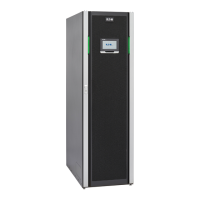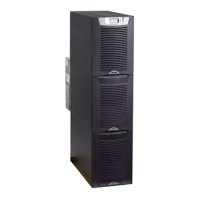43 Eaton® 9390 (100–160 kVA) UPS Installation and Operation Manual 164201604—Rev F
battery, and fluctuations in load demand during the discharge. The greater the load, the less support time the
battery has. Decreasing the load generally increases the battery support time.
77..22 MMuullttiippllee MMoodduullee UUPPSS DDiissttrriibbuutteedd BByyppaassss SSyysstteemm
Distributed bypass parallel operation extends the normal operation of Eaton 9390 UPS units by offering
increased capacity and/or redundant capability. The parallel system continues to maintain power to the critical
loads during commercial electrical power brownout, blackout, overvoltage, undervoltage, and out–of–tolerance
frequency conditions. See sheets 4 through 6 of Figure 82 for a detailed relationship of the parallel system.
The output of the system is normally supplied by several uninterruptible power modules (UPMs). Multiple
UPMs are connected with their outputs in parallel (tied together) to provide a load level greater than the rating
of one UPM and/or for redundancy. The paralleled UPMs supply the output load with protected power as long
as the load does not exceed the combined rating of the paralleled UPMs.
The power system is redundant as long as one of the UPMs can be disconnected from the output bus and the
remaining UPMs can continue to supply power to the load without exceeding their ratings.
When the load is being supplied by the UPMs, the system output bus is continuously monitored for an
overvoltage or undervoltage condition. If an out of limits condition is detected, the paralleled UPMs transfer the
load to bypass using the UPM static switches.
Communication is required between the UPMs for system metering and mode control. System level
communication and control are accomplished using a Eaton Hot Sync CAN Bridge Card. A single building alarm
in each UPM, connected to the other UPMs in parallel, and tied to the bypass contactor auxiliary contacts in
each UPM are used for a secondary communication path. This arrangement ensures bypass control even if the
CAN bus is lost.
Up to four units can be paralleled for redundancy or capacity without any additional cabinets.
The system is paralleled for redundancy (1+1) in a system where two UPMs are paralleled together and the
load is less than the supporting capability of one of the UPMs. The system is paralleled for capacity (2+0) if
both UPMs in a system are required to support the load.
A parallel capacity system can also be redundant (2+1), as long as there is always one or more UPMs online
than required to support the load.
77..22..11 MMuullttiippllee MMoodduullee PPaarraalllleell SSyysstteemm MMooddeess
Similar to the single module system, the Eaton 9390 UPS parallel system supports a critical load in three
different modes of operation. The standard operation modes are:
• In Normal mode, the paralleled UPMs supply the critical load with clean, filtered power. Each UPM battery
charger also provides charging current for the battery if needed.
• In Energy Saver mode, commercial AC power is supplied directly to the critical load through the continuous
static switch and transfers automatically to Online mode if an abnormal condition is detected. The Energy
Saver mode requires a UPS with a continuous static switch. Energy Saver mode in a parallel system
operates the same as it does in a single UPS system (see 7.1.4 Energy Saver Mode – RT).
• In Battery mode, the battery provides DC power, which maintains UPM operation. The UPM batteries
support the critical load.
• In Bypass mode, the critical load is directly supported by utility power through the continuous-duty static
bypass switch in each UPM.
The UPMs continually monitor themselves and the incoming utility power, and automatically switch between
these modes as required, without operator intervention, except when manually switching to Bypass mode. The
sophisticated detection and switching logic inside the UPMs ensures that operating mode changes are
automatic and transparent to the critical load, while internal monitoring systems indicate the current mode of
operation. The UPMs switch operating modes in response to these system events:
Understanding UPS Operation

